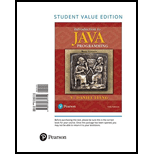
a)
Abstract class:
An abstract class is a class which may or may not include abstract methods and cannot be instantiated but rather can be sub classed.
Interface:
Interface is a reference type in Java, which contains a collection of abstract methods.
An interface needs to follow certain conditions such as:
- One cannot instantiate an interface.
- Interfaces do not contain any constructors.
- All methods present in the interface are abstract.
- An interface does not contain any instance field.
- An interface cannot be extended by a class.
Given code:
//interface declaration
interface A
{
//declaration of function
void print() { };
}
b)
Abstract class:
An abstract class is a class which may or may not include abstract methods and cannot be instantiated but rather can be sub classed.
Interface:
Interface is a reference type in Java, which contains a collection of abstract methods.
An interface needs to follow certain conditions such as:
- One cannot instantiate an interface.
- Interfaces do not contain any constructors.
- All methods present in the interface are abstract.
- An interface does not contain any instance field.
- An interface cannot be extended by a class.
Given code:
//interface declaration
abstract interface A
{
//declaration of function
abstract void print() { };
}
c)
Abstract class:
An abstract class is a class which may or may not include abstract methods and cannot be instantiated but rather can be sub classed.
Interface:
Interface is a reference type in Java, which contains a collection of abstract methods.
An interface needs to follow certain conditions such as:
- One cannot instantiate an interface.
- Interfaces do not contain any constructors.
- All methods present in the interface are abstract.
- An interface does not contain any instance field.
- An interface cannot be extended by a class.
Given code:
//interface declaration
abstract interface A
{
//declaration of function
print() { };
}
d)
Abstract class:
An abstract class is a class which may or may not include abstract methods and cannot be instantiated but rather can be sub classed.
Interface:
Interface is a reference type in Java, which contains a collection of abstract methods.
An interface needs to follow certain conditions such as:
- One cannot instantiate an interface.
- Interfaces do not contain any constructors.
- All methods present in the interface are abstract.
- An interface does not contain any instance field.
- An interface cannot be extended by a class.
Given code:
//interface declaration
interface A
{
//declaration of function
Void print();
}
e)
Abstract class:
An abstract class is a class which may or may not include abstract methods and cannot be instantiated but rather can be sub classed.
Interface:
Interface is a reference type in Java, which contains a collection of abstract methods.
An interface needs to follow certain conditions such as:
- One cannot instantiate an interface.
- Interfaces do not contain any constructors.
- All methods present in the interface are abstract.
- An interface does not contain any instance field.
- An interface cannot be extended by a class.
Given code:
//interface declaration
interface A
{
//declaration of function
default void print() { }
}
f)
Abstract class:
An abstract class is a class which may or may not include abstract methods and cannot be instantiated but rather can be sub classed.
Interface:
Interface is a reference type in Java, which contains a collection of abstract methods.
An interface needs to follow certain conditions such as:
- One cannot instantiate an interface.
- Interfaces do not contain any constructors.
- All methods present in the interface are abstract.
- An interface does not contain any instance field.
- An interface cannot be extended by a class.
Given code:
//interface declaration
interface A
{
//declaration of static function
static int get
{
//return value
return 0;
}
//Close interface
}
Want to see the full answer?
Check out a sample textbook solution
Chapter 13 Solutions
Introduction to Java Programming and Data Structures: Brief Version (11th Global Edition)
 Programming with Microsoft Visual Basic 2017Computer ScienceISBN:9781337102124Author:Diane ZakPublisher:Cengage Learning
Programming with Microsoft Visual Basic 2017Computer ScienceISBN:9781337102124Author:Diane ZakPublisher:Cengage Learning Microsoft Visual C#Computer ScienceISBN:9781337102100Author:Joyce, Farrell.Publisher:Cengage Learning,
Microsoft Visual C#Computer ScienceISBN:9781337102100Author:Joyce, Farrell.Publisher:Cengage Learning, New Perspectives on HTML5, CSS3, and JavaScriptComputer ScienceISBN:9781305503922Author:Patrick M. CareyPublisher:Cengage Learning
New Perspectives on HTML5, CSS3, and JavaScriptComputer ScienceISBN:9781305503922Author:Patrick M. CareyPublisher:Cengage Learning EBK JAVA PROGRAMMINGComputer ScienceISBN:9781337671385Author:FARRELLPublisher:CENGAGE LEARNING - CONSIGNMENTProgramming Logic & Design ComprehensiveComputer ScienceISBN:9781337669405Author:FARRELLPublisher:Cengage
EBK JAVA PROGRAMMINGComputer ScienceISBN:9781337671385Author:FARRELLPublisher:CENGAGE LEARNING - CONSIGNMENTProgramming Logic & Design ComprehensiveComputer ScienceISBN:9781337669405Author:FARRELLPublisher:Cengage EBK JAVA PROGRAMMINGComputer ScienceISBN:9781305480537Author:FARRELLPublisher:CENGAGE LEARNING - CONSIGNMENT
EBK JAVA PROGRAMMINGComputer ScienceISBN:9781305480537Author:FARRELLPublisher:CENGAGE LEARNING - CONSIGNMENT





